Imagine the sight of vibrant flowers covering your yard, offering not only visual appeal but a haven for pollinators, too. But what if space constraints or concerns about overshadowing other plants put a damper on your gardening dreams? Enter the world of dwarf flowering trees. Perfectly sized for smaller landscapes, these diminutive wonders deliver all the magnificence of their larger counterparts without their overwhelming stature. In this article, we’ll explore 20 fantastic dwarf flowering trees that breathe life and color into your outdoor space without dominating it. Let’s get into it.
1. Dwarf Bottlebrush Tree (Callistemon)

The dwarf bottlebrush tree is a flowering tree native to Australia.
©Rose Marinelli/Shutterstock.com
True to its name, the flowers of this tree resemble the bristles of a bottle brush, bursting forth in vibrant shades of red. However, some varieties also exhibit pink or white blossoms. Typically, dwarf varieties reach a modest height of 3 feet, although regular pruning can maintain an even smaller stature. This makes them an ideal choice for smaller gardens or landscapes. Native to Australia, the bottlebrush tree thrives in warm climates and is often found in USDA zones 8 through 12.
This sun-loving tree prefers well-draining soil and, once established, is relatively drought-tolerant. However, during its formative years, regular watering is essential. For best flowering results, place the tree where it can bask in full sun and occasionally feed it with a balanced, slow-release fertilizer.
2. Dwarf Crape Myrtle (Lagerstroemia)

A gorgeous flower thriving in UDA zones 6 to 9, the crape myrtle boasts beautiful flowers.
©LifeCollectionPhotography/Shutterstock.com
The crape myrtle is a beloved staple in many gardens, celebrated for its prolonged blooming period and its exuberant displays of flowers in shades ranging from white and pink to deep red and purple. The dwarf varieties of this tree maintain all the charm of their taller kin, often reaching a maximum height of 4 feet, which makes them ideally suited for more compact spaces or as border plants. Native to Southeast Asia and Northern Australia, crape myrtles have comfortably made their mark in warmer parts of the United States, particularly in USDA zones 6 through 9.
These flowering trees are known for their heat and drought tolerance once established. However, you must provide them with well-draining soil and ample water during their initial growing years. Pruning, particularly in late winter or early spring, can enhance their shape and boost their flowering potential.
3. Blue Chinese Wisteria Tree (Wisteria sinensis)
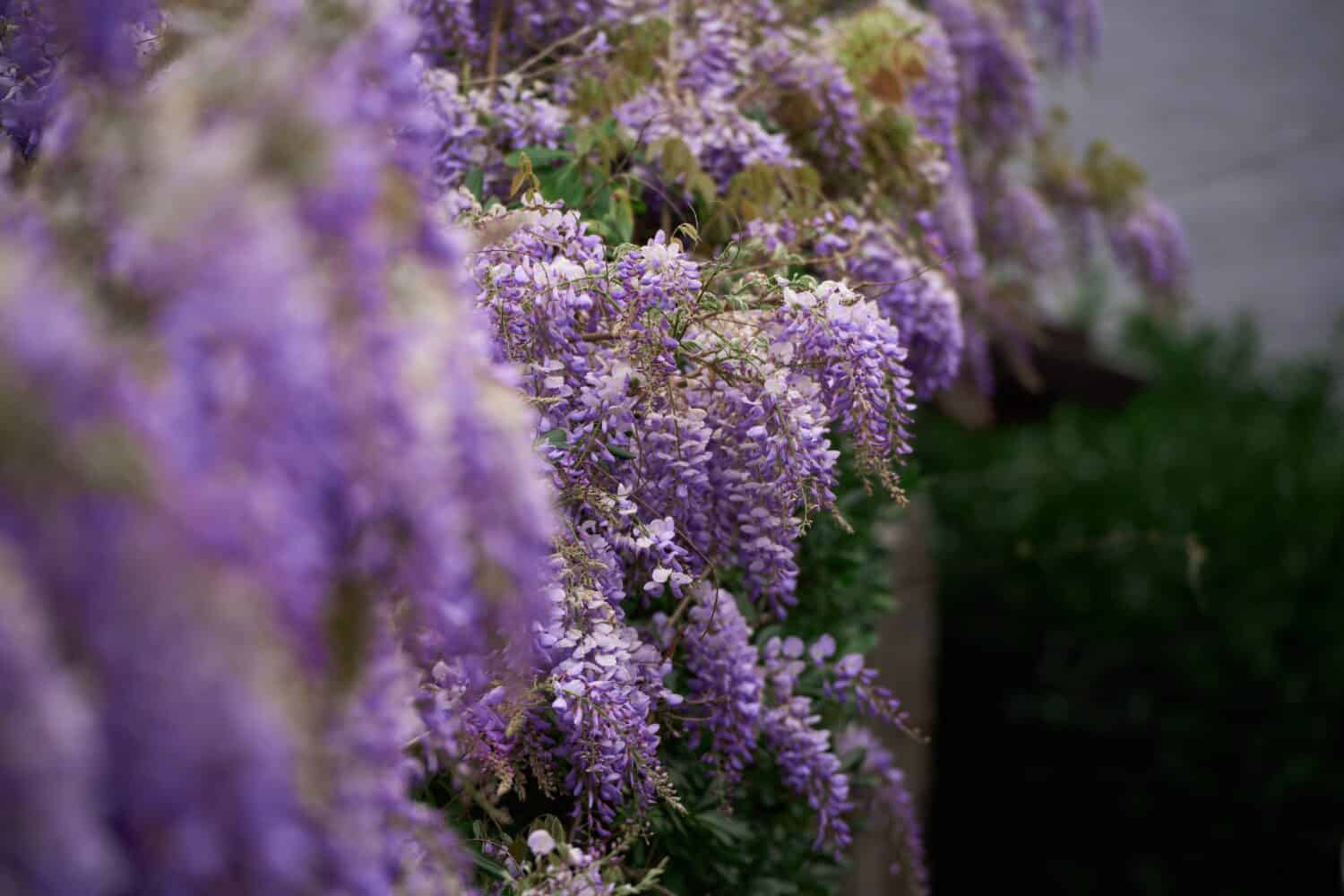
Blue Chinese wisteria trees boast drooping clusters of blooms.
©alexgo.photography/Shutterstock.com
The dwarf wisteria tree typically stands between 6 and 10 feet tall, making it a suitable centerpiece for small gardens or patios. Native to China, the blue Chinese wisteria tree thrives in temperate regions and is best suited for USDA zones 5 through 9. This is an absolutely gorgeous plant for gardens, as this flowering tree boasts stunning drooping clusters of blooms that appear in late spring. These clusters result in a dramatic floral display followed by pods and dark green leaves.
To ensure the most abundant blooming, plant the blue Chinese wisteria tree in a location that receives full sun, though it can tolerate partial shade. The tree prefers moist, well-draining soil. Periodic pruning, especially after the flowering season, can help maintain its shape and size and encourage more blooms the following spring.
4. Chaste Tree (Vitex agnus-castus)
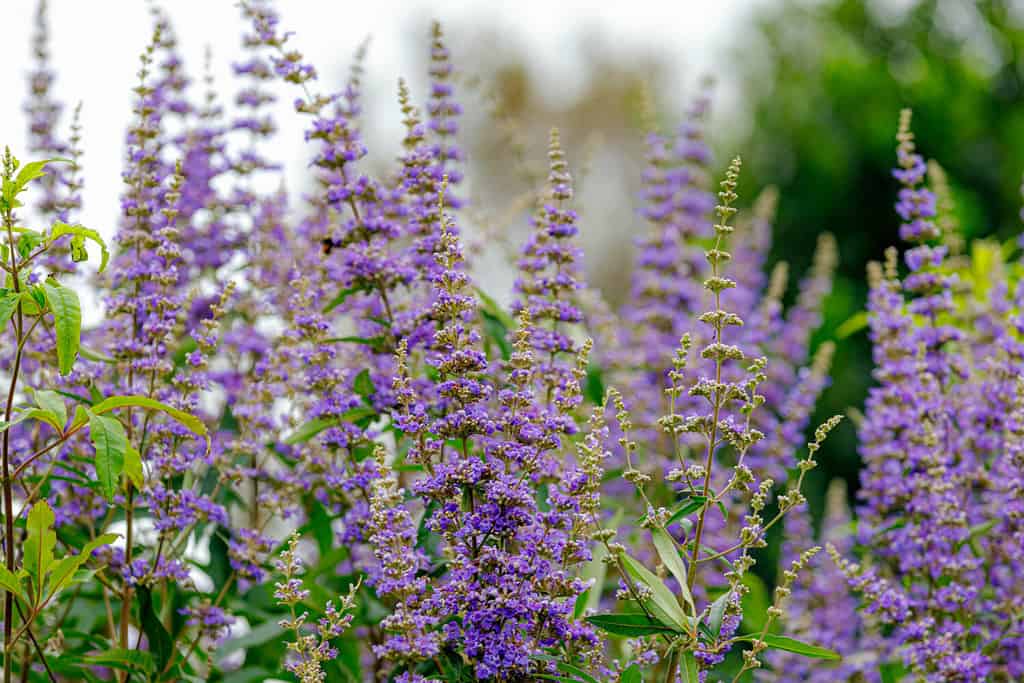
Boasting lavender-blue flower spikes, dwarf varieties of chaste trees grow under 10 feet tall.
©Wut_Moppie/Shutterstock.com
Some chaste trees can grow more prominent, up to 20 feet tall and wide! But many dwarf varieties remain well under 10 feet, fitting into smaller gardens or as a focal point in landscape designs. The chaste tree has comfortably acclimated to various environments, especially thriving in USDA zones 7 through 8. Interestingly, although this plant is a perennial, it will die back and regrow and flower in the spring. But when it does flower, it boasts lavender-blue flower spikes!
The tree should be in full sun to revel in its best blooming, though it can be managed in light shade. Pruning in late winter or early spring can be beneficial to maintain a bushy appearance and stimulate more flowering.
5. Dragon Tree (Dracaena draco)

While dragon trees are naturally huge, dwarf varieties grow up to 15 feet.
©Wirestock Creators/Shutterstock.com
The dragon tree’s appearance is characterized by an umbrella-like canopy of long, slender leaves shooting up from a thick, singular trunk. Mature dragon trees can grow incredibly tall in their native habitats, but dwarf varieties remain compact, typically reaching heights of 10 to 15 feet. Native to the Canary Islands, the dragon tree thrives in arid climates, preferring USDA zones 9 through 12. While not known for its flowers, the dragon tree does bloom with green-white flowers in the early summer.
This tree is relatively low-maintenance, appreciating a sunny spot with partial afternoon shade. Once established, the tree is drought-tolerant and requires minimal watering.
6. Japanese Maple (Acer palmatum)

Dwarf varieties of the flowering Japanese maple tree are less than 10 feet tall.
©iStock.com/Michel VIARD
The Japanese maple tree is renowned for its uniquely shaped leaves that change colors with the seasons, transitioning from greens in spring to striking shades of red, orange, or even deep purple in the fall. They typically bloom between May and June, with tiny red flowers in clusters. Dwarf varieties are more compact, typically reaching heights of 3 to 8 feet, depending on the type. Native to Asia, these trees are well-suited to temperate climates, growing best in USDA zones 5 through 8.
Japanese maples prefer a sheltered spot with dappled sunlight for optimal growth, especially in areas with intense afternoon sun. They thrive in moist, well-draining soil with a slightly acidic pH. Keeping their roots moist is essential, especially in hotter periods, but avoid waterlogged conditions. Minimal pruning is required, primarily for shaping and removing any dead or crossing branches, ideally done in the late fall or winter when the tree is dormant.
7. Jack Dwarf Pear (Pyrus calleryana ‘Jaczam’)
This compact tree produces juicy, sweet pears despite its small stature. Its spring bloom is a sight to behold, with clusters of white flowers blanketing the tree, hinting at the fruit harvest. Native to temperate regions, these dwarf pear trees thrive in USDA zones 5 through 8.
For optimal fruit production, Jack dwarf pear trees require a sunny spot with well-draining soil. Regular watering is essential, especially during dry spells, but it’s vital to avoid waterlogging to prevent root rot. Annual pruning in late winter, before the onset of spring growth, helps maintain the tree’s shape, remove dead or diseased branches, and enhance fruit yield. Fertilization using a balanced fruit tree fertilizer in early spring can further boost its health and productivity.
8. Franklin Tree (Franklinia)
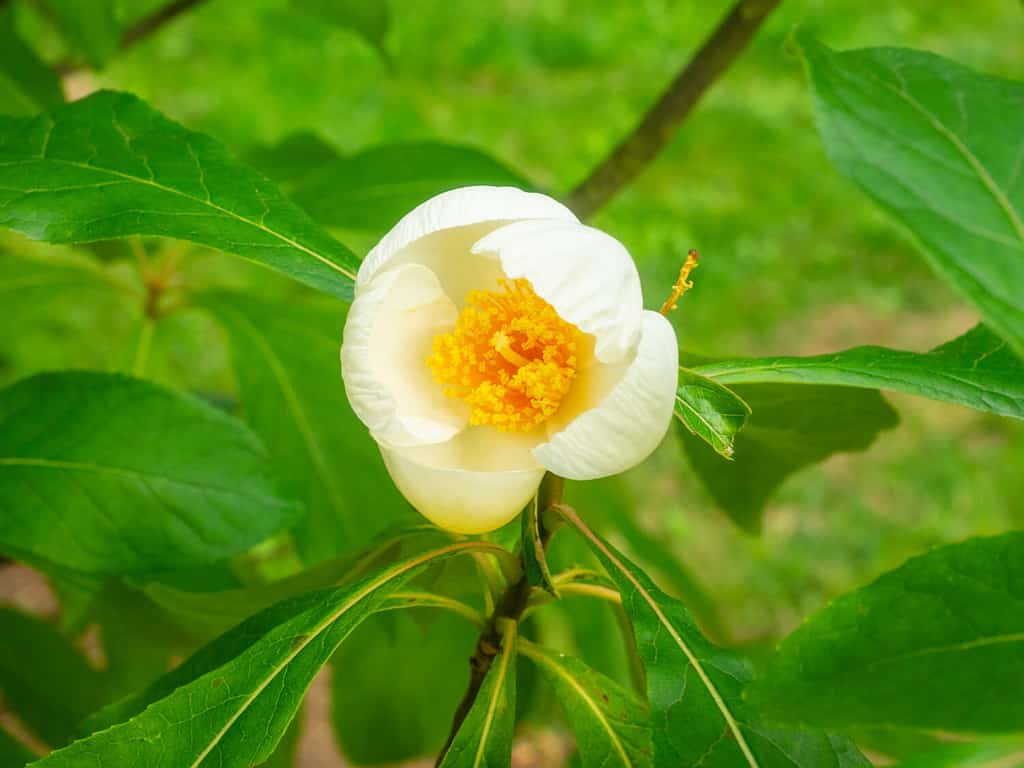
The Franklin tree blooms look like camellias.
©Mariusz S. Jurgielewicz/Shutterstock.com
This unique Franklin tree is named in honor of Benjamin Franklin. It is known to have grown naturally only along the banks of the Altamaha River in Georgia and has been extinct in the wild since 1803! The Franklin tree reaches 10 to 20 feet and spreads about 6 to 15 feet wide. Its flowers, which resemble camellias, bloom late in the summer to early fall, providing a rare treat during a season when few trees flower. Its leaves turn a brilliant array of oranges, reds, and even purples in the fall.
While the Franklin tree prefers consistent moisture, especially when young, avoid waterlogged conditions, as the tree is susceptible to root rot. The tree grows well in USDA zones 5 to 9, and mulching can help retain soil moisture and protect its relatively shallow root system.
9. Dwarf Powder Puff Tree (Calliandra haematocephala)

As evidenced by its name, the dwarf powder puff tree has flowers that look like fluffy puffs.
©Andi WG/Shutterstock.com
The dwarf powder puff tree is another dwarf flowering tree celebrated for its visually striking blooms. As the name suggests, the tree’s flowers resemble soft, fluffy powder puffs, with long, fine stamens grouped in spherical clusters. These puffs are primarily in vibrant shades of red or pink. The dwarf powder puff tree is a tropical to subtropical plant that typically reaches heights of 5 feet when cultivated. However, it can grow taller in its natural habitat.
The powder puff tree requires a warm climate to thrive and is best suited to USDA zones 9 through 11. It prefers full sun to partial shade and thrives in well-draining soil. This tree requires light pruning after its flowering season to maintain its compact shape and promote more prolific blooming.
10. Frangipani (Plumeria)

Some varieties of the plumeria or frangipani are dwarf flowering trees.
©iStock.com/rweisswald
The frangipani is a tropical marvel recognized for its intensely fragrant and vibrant blossoms. This tree is particularly noted for its rich-smelling flowers, which can produce blooms in shades of pink, yellow, red, and white. Each flower has five velvety petals, forming a distinct spiral pattern at the center. The tree has a thick trunk with slender branches that showcase clusters of long, dark green leaves. Dwarf frangipani varieties typically grow up to 10 feet.
Native to warm regions, the tree thrives best in USDA zones 10 through 12. It requires a sunny location and well-draining soil, as its roots are susceptible to rot in prolonged wet conditions.
11. Purple Leaf Sand Cherry (Prunus x cistena)
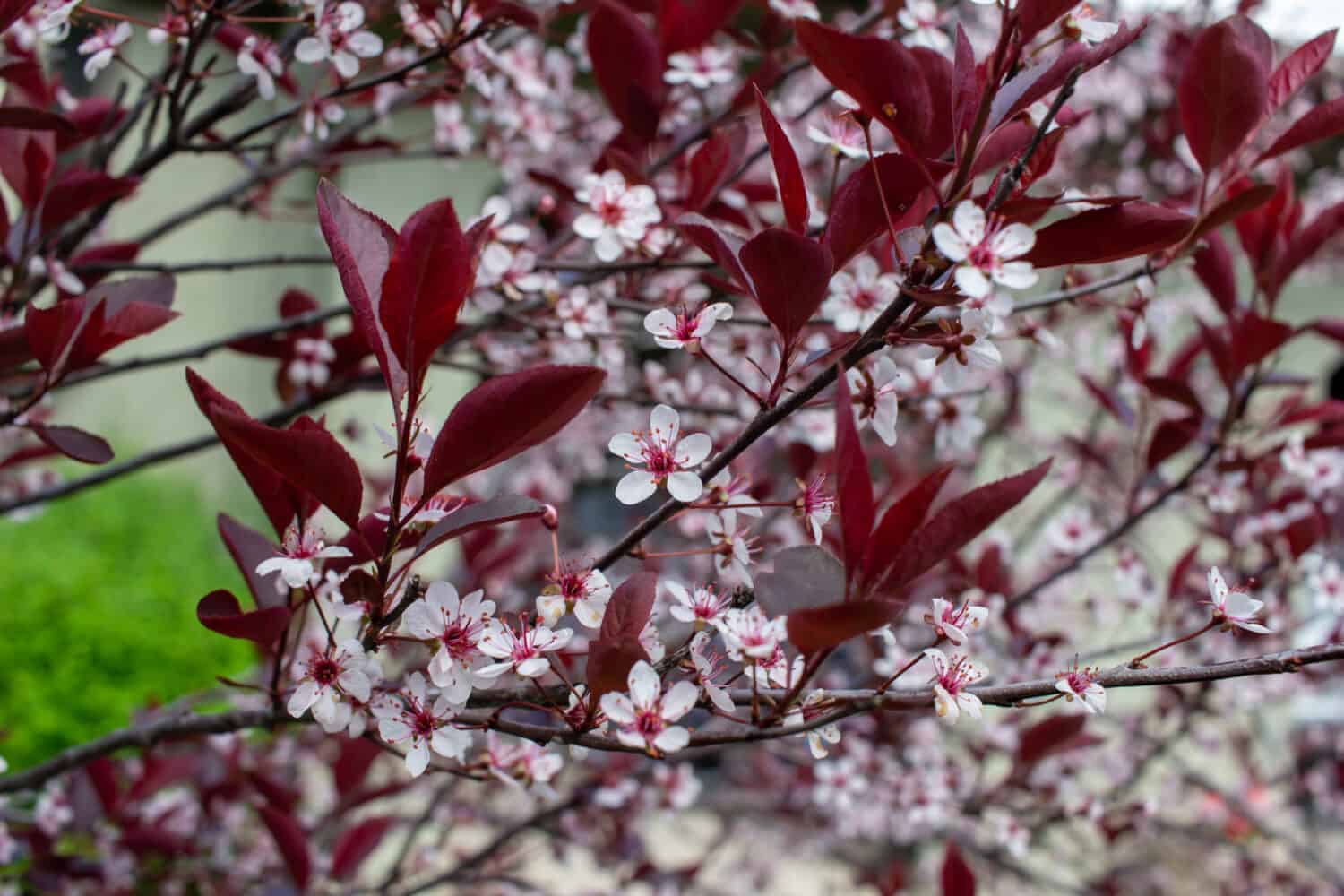
The purple leaf sand cherry is a gorgeous dwarf flowering plant.
©Cynthia Shirk/Shutterstock.com
Also called the dwarf red-leaf plum, this deciduous plant presents a contrast in gardens. The purple leaf sand cherry tree’s leaves serve as a vibrant backdrop to the pinkish-white blossoms that emerge in early spring. As a bonus, by summer’s end, the tree bears small, dark purple fruits which, although a bit tart, are edible and can attract various birds.
This tree is well-suited for USDA zones 2 through 8. The purple leaf sand cherry prefers full sun and requires well-draining and rich soil. Though it can tolerate various soil conditions, it appreciates some moisture and benefits from mulching.
12. Sasanqua Camellia (Camellia sasanqua)
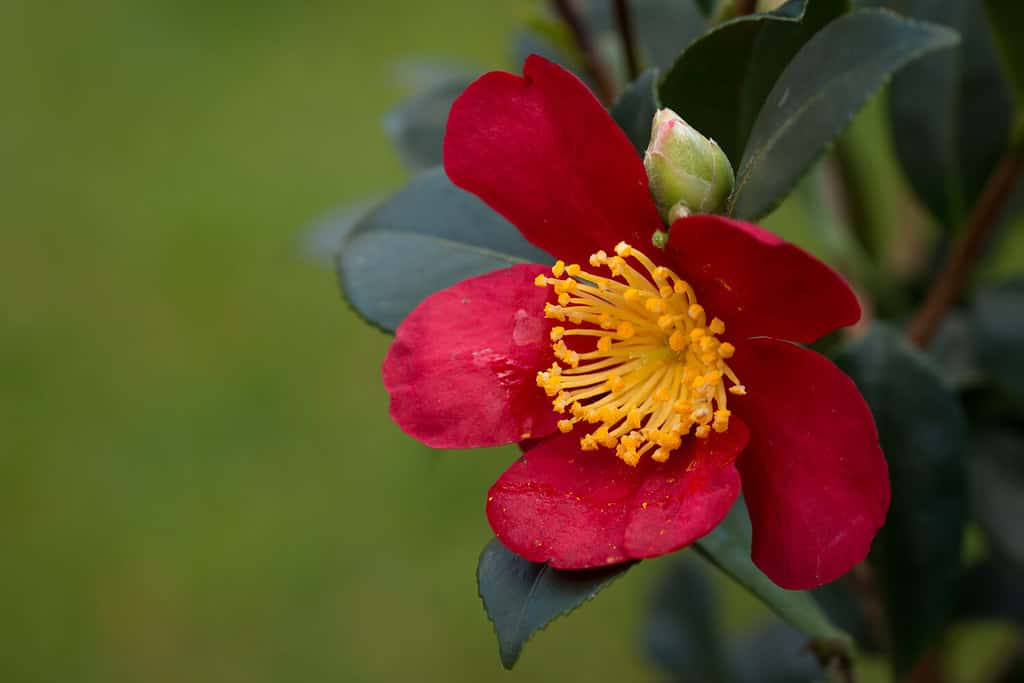
Sasanqua blooms later in the season.
©NEWMANM/Shutterstock.com
The sasanqua is a member of the camellia family, distinguished by its later blooming season and slightly smaller, yet equally stunning, flowers. Often found in gardens in the fall and early winter, the sasanqua showcases a variety of colors from white to deep pink, with petals arranged in single or double formations around a central cluster of its stamens.
This tree thrives best in USDA zones 7 to 9 and prefers well-draining, slightly acidic soil while being protected from harsh sun. Regular watering is essential, especially in dry conditions, but avoid waterlogged soil. Proper pruning, primarily to remove dead or weak growth, should be conducted after its flowering period to ensure healthy growth and prolific blooms in subsequent seasons.
13. Dwarf Redbud (Cercis)
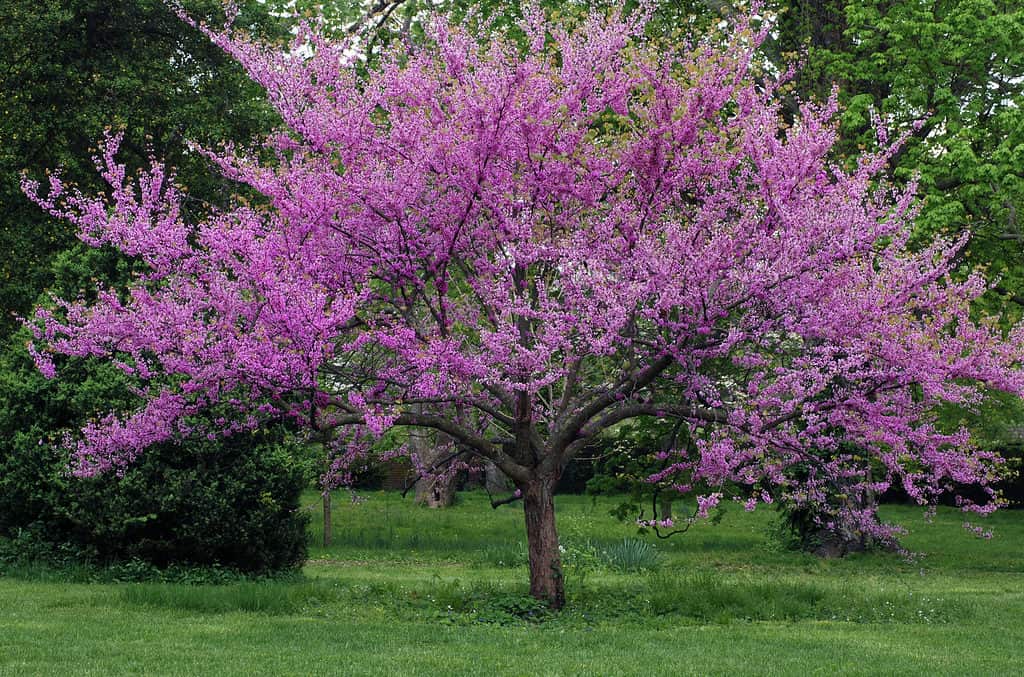
Some varieties of redbud trees are less than 12 feet tall.
©Marie C Fields/Shutterstock.com
There are many varieties of dwarf redbuds. The redbud is a tree that signals the arrival of spring with its profusion of vivid, rosy-pink blooms. Before the emergence of its heart-shaped leaves, these tiny blossoms adorn the redbud’s branches, growing directly on its bark. The tree’s rich green foliage follows shortly after the flowering period. And in the fall, the green leaves turn yellow. While some species of redbud can grow up to 30 feet, there are dwarf varieties that mature at a modest 6 to 12 feet, fitting snugly in smaller gardens or landscapes.
Redbuds are versatile, with varieties suited to USDA zones 4 through 9. Redbuds prefer well-draining soil for optimal growth and can thrive in full sun to partial shade. They’re relatively drought-tolerant once established but benefit from consistent moisture during their formative years.
14. Sargent Crabapple (Malus sargentii)
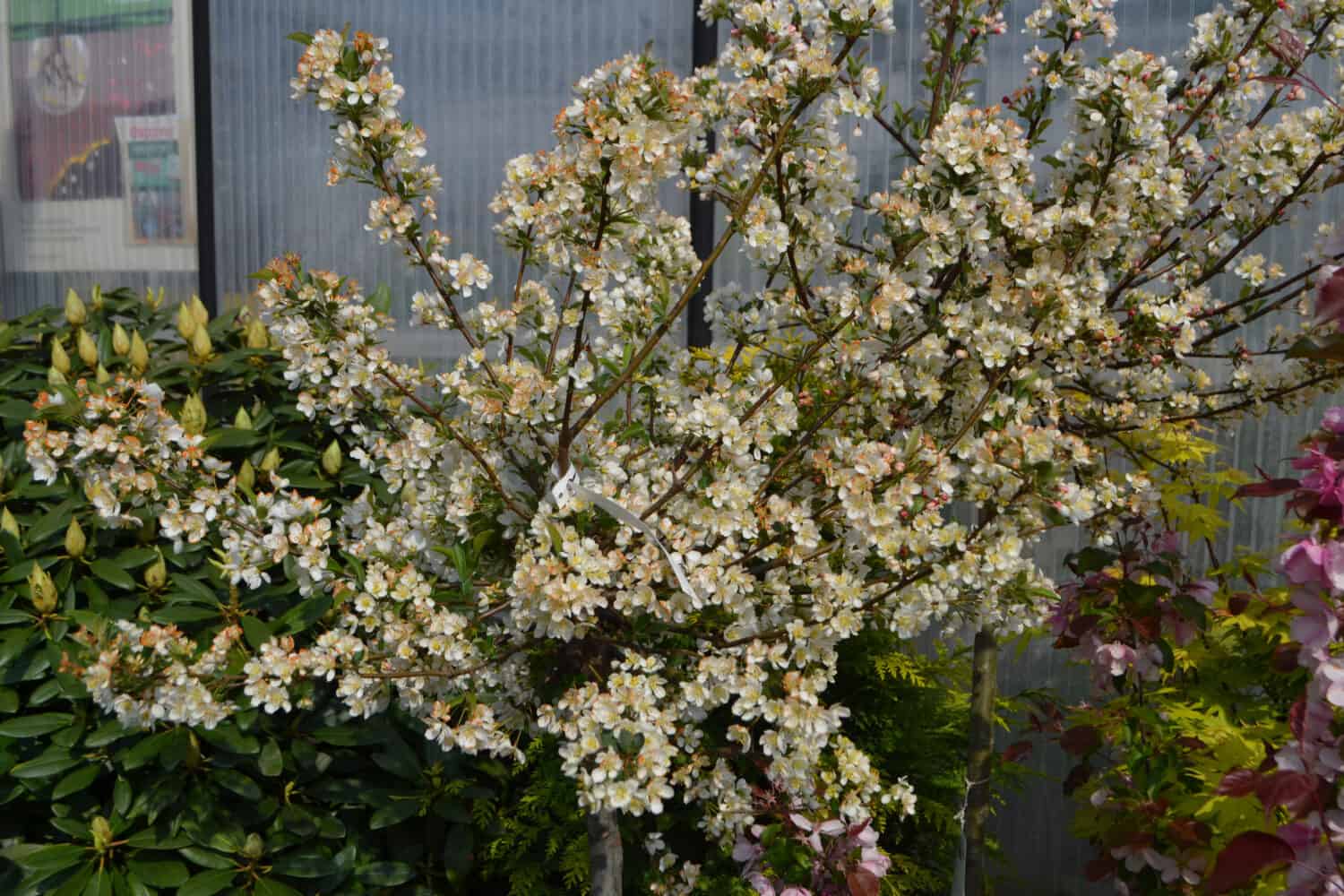
An ornamental tree, the Sargent crabapple attracts pollinators with its fragrant white blooms.
©Edita Medeina/Shutterstock.com
The Sargent crabapple is an ornamental tree cherished for its year-round visual appeal. Come spring, this dwarf tree is decked with a profusion of fragrant white blossoms, which are a magnet for pollinators. The tree’s dense, dark green foliage turns various shades of yellow in the fall, adding another layer of visual interest. In the fall, the Sargent crabapple also boasts red fruits. Typically maturing to a height of 6 to 10 feet with a spread of up to 12 feet, this tree is an ideal choice for more miniature landscapes. The Sargent crabapple prefers to grow in USDA zones 5 through 8.
This dwarf flowering tree prefers full sun and well-draining soil for optimal growth and flower production, although it’s adaptable to various soil types. While moderately drought-tolerant, regular watering is beneficial, especially in drier conditions. Annual pruning in late winter can help maintain its shape and remove diseased or damaged growth.
15. Saucer Magnolia (Magnolia x soulangeana)
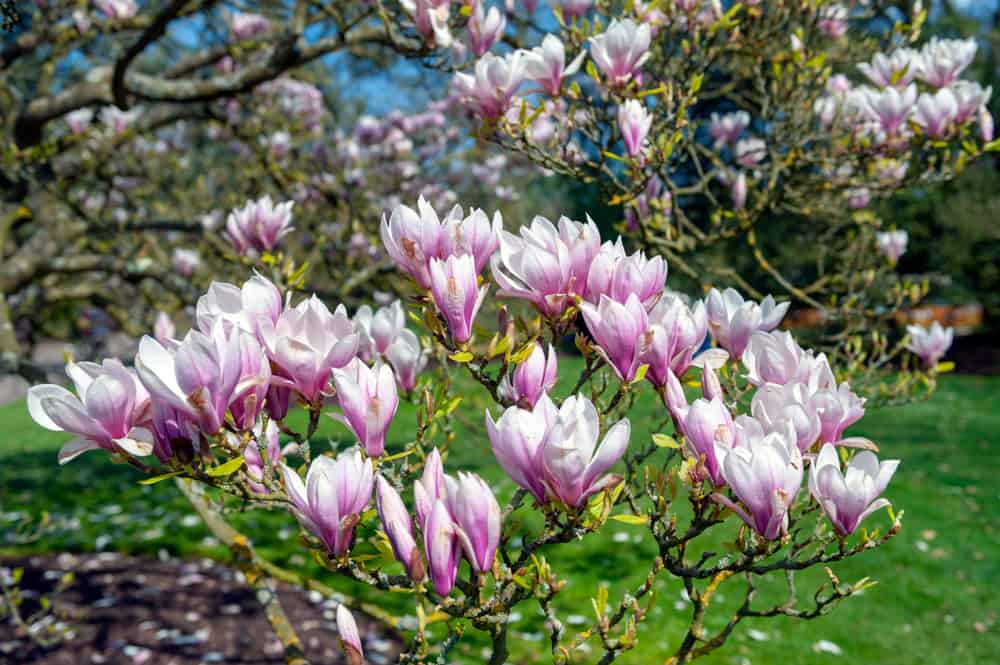
A dwarf flowering tree, the saucer magnolia boasts gorgeous cup-shaped blossoms.
©Gaid Kornsilapa/Shutterstock.com
The saucer magnolia is another dwarf tree that stands out as one of the most iconic spring-flowering trees. Celebrated for its large, cup-shaped blossoms, the saucer magnolia’s flowers blend pink, white, and purple hues. Typically, these blooms appear before the tree’s dark green leaves unfurl, creating a contrast against the bare branches. While the tree can reach 15 to 25 feet, many varieties can be smaller.
Saucer magnolia trees thrive in USDA zones 5 through 9. For best results, plant this magnolia in a location with well-draining soil with full sun to partial shade. It prefers slightly acidic soil and may benefit from a mulch layer around its base to retain moisture and regulate soil temperature. While the mature trees are somewhat drought-tolerant, it’s essential to water younger trees consistently.
16. Smoketree (Cotinus)
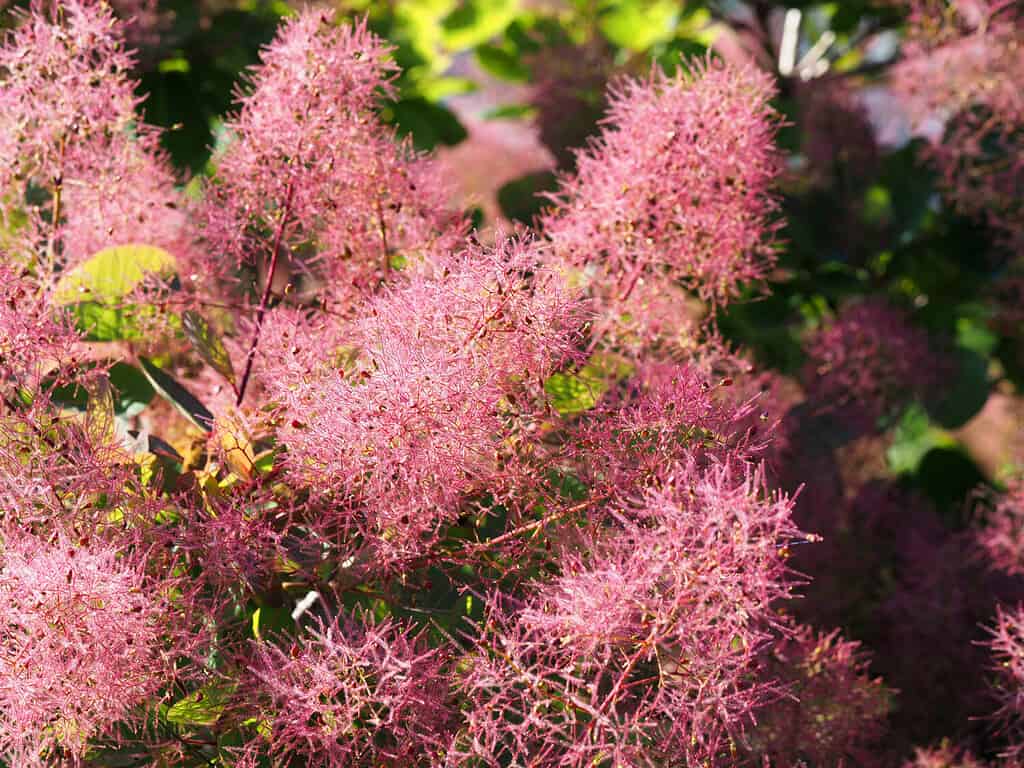
Named for its smoke-like appearance, the smoketree prefers full sun.
©ANGHI/Shutterstock.com
The smoketree is a unique ornamental tree celebrated for its smoke-like appearance. During the summer, the tree produces feathery, cloud-like plumes that appear to envelop its branches, giving it its name. These “smoky” clusters are not flowers but rather enlarged hair-covered stalks that persist after the smaller flowers have finished blooming. Beyond its distinctive plumes, wide smoketree varieties boast vibrant purple, red, or green foliage, which can turn orange or gold in the fall. While some species can grow up to 15 feet tall, dwarf varieties maintain a more compact size, some as small as 4 feet.
Native to warm temperate regions of the northern hemisphere, smoke trees can be planted in USDA zones 4 through 8. They prefer full sun to bring out the best leaf color and require well-draining soil. Remarkably drought-tolerant, they can adapt to various soil conditions, although they do appreciate a bit of moisture once established.
17. Weeping Cherry (Prunus pendula)
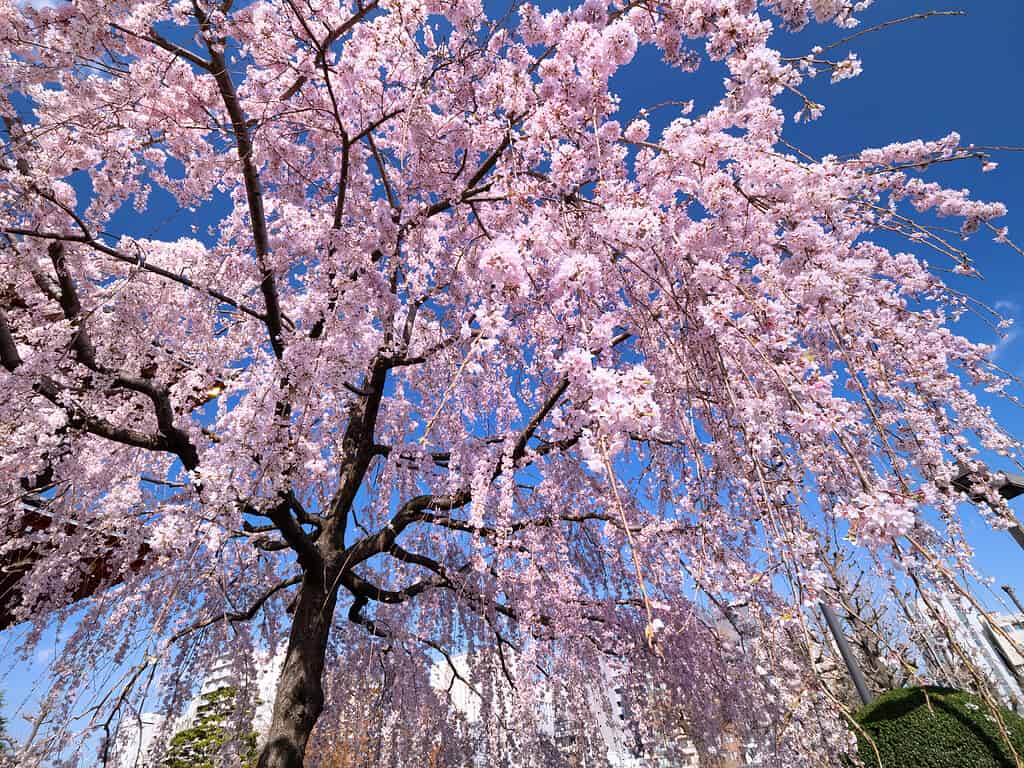
The weeping cherry dwarf varieties grow up to 15 feet tall.
©y-studio/iStock via Getty Images
Every spring, the weeping cherry tree transforms into a floral spectacle, its drooping limbs covered in delicate pale pink to white flowers. The dwarf varieties reach 8 to 15 feet, with their gracefully arching branches spreading equally wide.
Native to Japan, the weeping cherry prefers well-draining soil and thrives in full sun to partial shade. It’s best suited for USDA zones 6 to 8. While you can plant the weeping cherry tree wherever you want, many opt to plant this tree near water bodies so that the beautiful weeping form can reflect.
18. Utah Serviceberry (Amelanchier utahensis)

Growing up to 15 feet tall, the Utah serviceberry is a dwarf flowering tree.
©Danita Delimont/Shutterstock.com
The Utah serviceberry is another small tree native to the United States. It produces white blossoms in clusters during early spring, which mature into small, edible, dark purple berries by early summer. The sweet nectar of the white flowers attracts a variety of pollinators, including bees and butterflies. The tree’s leaves are oval-shaped, turning from a fresh green hue in spring and summer to shades of orange and red in the fall. This tree grows up to 10 to 15 feet tall.
Thriving in USDA zones 5 through 8, the Utah serviceberry is naturally adapted to various sandy and rocky soils. It prefers well-draining soil in full sun to partial shade for optimal growth.
19. Stewartia (Stewartia)

Boasting camellia-like white flowers, the Stewartia grows in USDA zones 5 to 8.
©lenic/Shutterstock.com
The Stewartia is a smaller tree renowned for its year-round ornamental appeal. In early to mid-summer, it showcases camellia-like white flowers with prominent orange-yellow anthers set against dark green leaves. In the fall, these leaves transition to a vibrant red, orange, and burgundy tapestry. Stewartia typically reaches 15 to 30 feet, depending on the species and how often it is pruned.
Native to woodland areas, the stewartia grows in USDA zones 5 to 8. For best growth, plant this tree in well-draining, acidic soil in a location with full sun to partial shade. The stewartia is somewhat drought-tolerant once established.
20. Star Magnolia (Magnolia stellata)
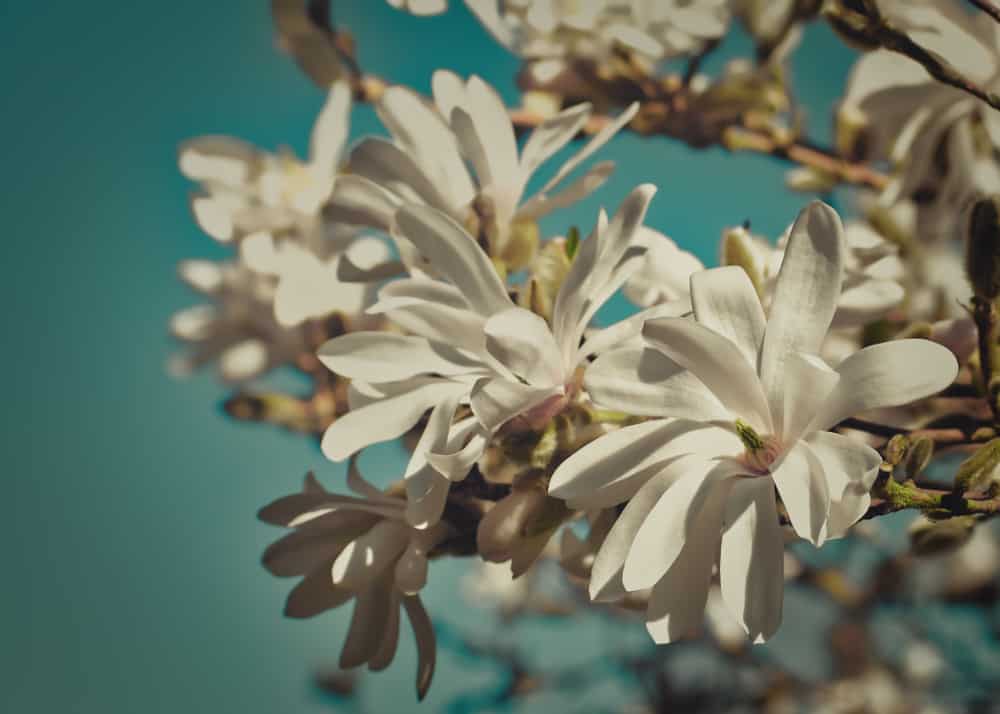
One of the best dwarf flowering trees is the star magnolia.
©SwedishStockPhotos/Shutterstock.com
The star magnolia is a compact tree known for its early spring explosion of star-shaped white flowers. Each blossom, made up of slender, radiating petals, gives the tree an ethereal appearance. This magnolia’s leaves are oblong and light green, providing a nice backdrop after the tree has finished its flowering.
For best growth and flower production, the tree should be planted in USDA zones 4 through 9, in well-draining soil in full sun to partial shade. While it can tolerate various soil types, it prefers slightly acidic soil. Watering should be consistent, but a mature star magnolia is relatively resistant to drought as well.
Summary of the Best Dwarf Flowering Trees to Spruce Up Any Yard
| Number | Dwarf Flowering Tree | Botanical Name |
|---|---|---|
| 1. | Dwarf Bottlebrush Tree | Callistemon |
| 2. | Dwarf Crape Myrtle | Lagerstroemia |
| 3. | Blue Chinese Wisteria Tree | Wisteria sinensis |
| 4. | Blue Diddley Chaste Tree | Vitex agnus-castus |
| 5. | Dragon Tree | Dracaena draco |
| 6. | Japanese Maple | Acer palmatum |
| 7. | Jack Dwarf Pear | Pyrus calleryana ‘Jaczam’ |
| 8. | Franklin Tree | Franklinia |
| 9. | Dwarf Powder Puff Tree | Calliandra haematocephala |
| 10. | Frangipani | Plumeria |
| 11. | Purple Leaf Sand Cherry | Prunus x cistena |
| 12. | Sasanqua Camellia | Camellia sasanqua |
| 13. | Dwarf Redbud | Cercis |
| 14. | Sargent Crabapple | Malus sargentii |
| 15. | Saucer Magnolia | Magnolia x soulangeana |
| 16. | Smoketree | Cotinus |
| 17. | Weeping Cherry | Prunus pendula |
| 18. | Utah Serviceberry | Amelanchier utahensis |
| 19. | Stewartia | Stewartia |
| 20. | Star Magnolia | Magnolia stellata |
The photo featured at the top of this post is © alexgo.photography/Shutterstock.com
Thank you for reading! Have some feedback for us? Contact the AZ Animals editorial team.







